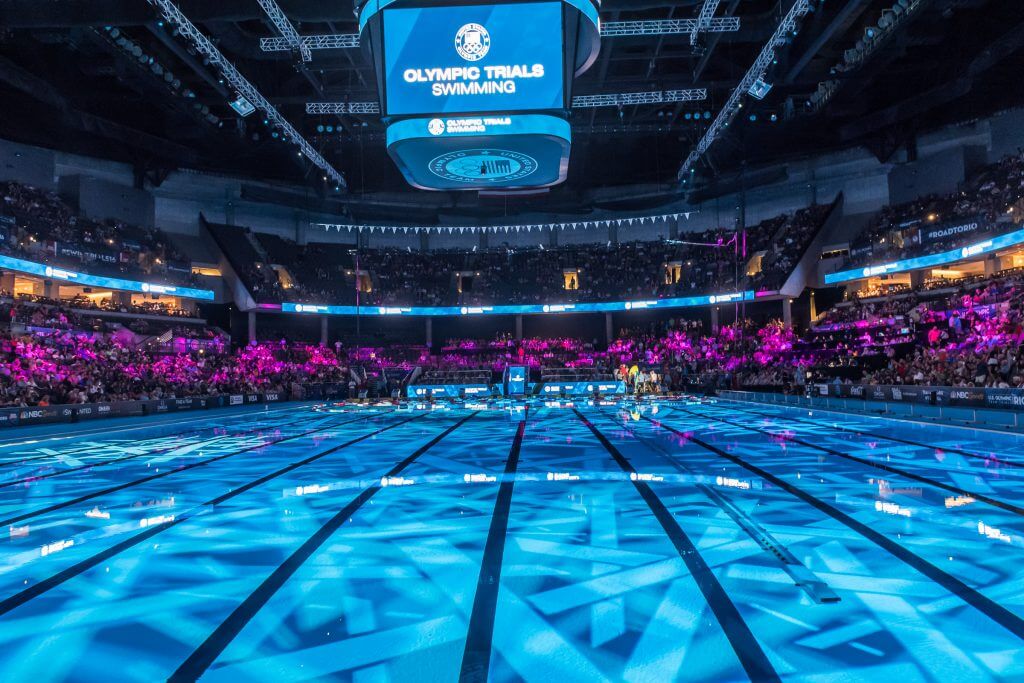From a Wave I Participant: 3 Advantages to Keeping a Two-Meet Olympic Trials

From a Wave I Participant: 3 Advantages to Keeping a Two-Meet Olympic Trials
By Lucy Callard, Swimming World College Intern
After an unprecedented year, USA Swimming selected the 2021 Olympic Team in unprecedented fashion: Two meets. With only three years until the next Trials, the question remains whether the meet will return to its original format or keep the Wave I and Wave II format. I was a spectator in Omaha for the 2016 Team Trials, and I competed last month at the Wave I meet.
As an athlete and a spectator, I experienced both methods of selecting the Olympic Team. While the two-meet format was implemented to ensure COVID-19 safety, there were some added benefits that should be considered for the 2024 Olympic Trials. Here are three advantages to keeping a Wave 1 meet for 2024:
Opportunity For Second Swims
Perhaps the greatest benefit of the Wave I meet was the opportunity for younger and less experienced swimmers to qualify for finals. Swimmers who were unlikely to qualify for semifinals had it been one meet had the opportunity for seconds swims and to improve on their morning performances. The Olympic Trials is unlike any other meet in the country and nerves often get the best of athletes during their first races on the big stage. The chance to swim at finals benefits not only the swimmers but also USA Swimming as it looks to build experienced Junior and Senior National Teams.
The opportunity to swim in finals during Wave I provided additional experience to a few young swimmers who will be in contention to make the 2024 Olympic team. Four years before qualifying for his first Olympics, Caeleb Dressel placed 152nd in the 100 free in 2012. In the same event, Abbey Weitzel finished 52nd in 2012 before becoming the back-to-back champion at Olympic Trials in 2016 and 2021. Following the same pattern, we may see several Wave I stars in the semifinal and final heats in 2024. With the experience of swimming at night in 2021, these swimmers will be even more prepared to compete for a spot on the Olympic team.
Plenty of Space for Warming Up and Warming Down
Every large meet comes with the difficulty of providing adequate pool space for athletes to properly warm up and warm down. At the Olympic Trials, eight 50-meter and six 25-meter lanes were available, in addition to the competition pool in between sessions. As an athlete, I have swum in plenty of meets where the warmup facilities are overflowing and there is almost no space to properly get ready. Not only does this leave athletes unprepared for their races physically, but being unable to warm up can be extremely frustrating and distracting.
Splitting the meet allowed for adequate space to warm up in the days before the meet and during competition. With fewer bodies in the water competing for warmup space, I was able to prepare the best I could for my races. Warming up and warming down is essential for success at high level meets like the Olympic Trials. Both Wave I and Wave II swimmers benefited from having fewer athletes in the pool at each meet.
More Training Time Before Nationals and Junior Nationals
Wave I ended almost two weeks earlier than the completion of Wave II. In an already short summer season, tapering for Olympic Trials leaves only a few weeks afterward before Nationals and Junior Nationals in August. The two weeks following Wave I was an opportunity for swimmers to return to hard training and get a jumpstart on preparing for their end of the season meets.
A majority of swimmers at both Wave I and Wave II added time from their seeds at Olympic Trials. Nationals and Juniors Nationals offers these swimmers another opportunity to drop time and compete at a high-level meet. More time to train and reset from an Olympic Trials taper gives athletes a better chance to swim fast in August. While the swimmers may not have made the Olympic team, they have the opportunity to swim times that could qualify them for the National or Junior National teams.
All commentaries are the opinion of the author and do not necessarily reflect the views of Swimming World Magazine nor its staff.



